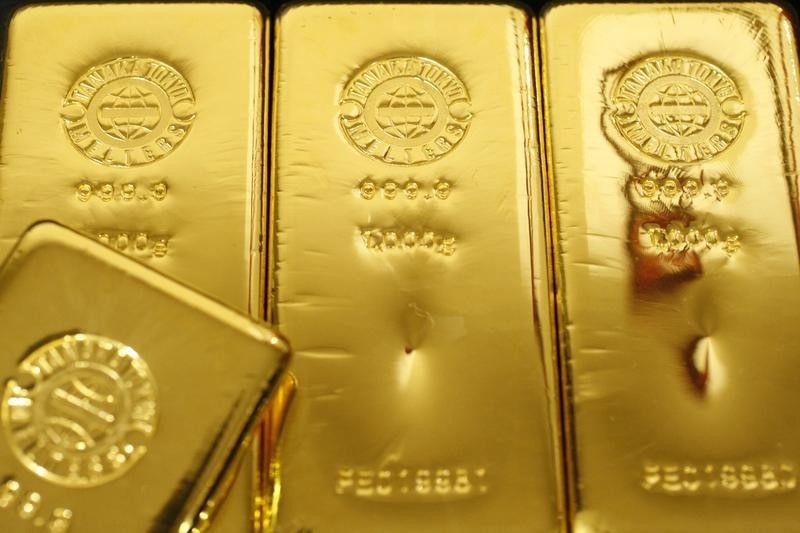--Clyde Russell is a Reuters columnist. The views expressed
are his own.--
By Clyde Russell
LAUNCESTON, Australia, July 21 (Reuters) - What does gold
have in common with iron ore and coal? All three are travelling
down the same road of structural oversupply, softer demand
growth and severe cost-cutting by their producers.
While exciting for gold watchers, Monday's mini flash crash,
which sent the most-active U.S. gold futures contract GCv1 to
a five-year low of $1,088 an ounce in thin early Asian trade, is
largely irrelevant, unless viewed against a wider backdrop.
The broad picture for gold is that since the spot price
XAU= reached its peak of $1,920.30 an ounce in September 2011,
demand has dropped as supply has risen.
More than anything else this simple dynamic explains why
gold has now given up about half the gains of the decade long
rally between 2001 and 2011.
Figures from Thomson Reuters GFMS show that in 2011 there
was an overall deficit of 154.1 tonnes in the gold market, which
fell to a deficit of 77.9 tonnes in 2012, then rose to a surplus
of 248.7 tonnes in 2013 and 358.1 tonnes last year.
While not entirely to blame for the rising surplus in the
market, mine supply has been on an upward trend, from 2,845.9
tonnes in 2011 to 3,129.4 tonnes last year, according to GFMS
data.
Mine supply is now projected to start declining, to 3,124.7
tonnes this year, 3,057 tonnes in 2016 and 2,970.3 in 2017.
This largely reflects the closure of higher-cost operations
and the scaling back of exploration expenditure in response to
low prices, which curtails new projects.
GFMS uses a robust methodology and has a strong track
record, but like all forecasters, it has to assume other factors
remain equal, and this is why forecasting is generally fraught
with risk.
COST CUTS LEAD TO LOWER PRICE
The main risk, from a supply perspective, is that miners are
able to manage costs in such a way as to lower the industry's
cost curve, allowing the price to fall in the absence of a
demand-driven rally.
This is why gold may be experiencing a similar dynamic as
iron ore and coal, even if it's not quite as far down the same
road.
What we've seen in iron ore and coal is that the most common
response by mining companies to falling prices for their
commodities is to increase volumes and cut costs.
The thinking is that by lowering unit costs the company will
be able to weather the period of low prices.
What has happened in practice is markets that were already
oversupplied became more so, and the reductions in the industry
cost curve simply allowed prices to fall by a similar amount.
Spot thermal coal at Australia's Newcastle port
GCLNWCWIDX , a regional benchmark, has lost more than half its
value since 2011, while spot iron ore .IO62-CNI=SI has fared
even worse, fetching just over a quarter of what it did at its
record high in early 2011.
While gold has also fallen by almost 50 percent, the miners
have been cushioned by fatter margins and it is only more
recently that costs will have moved to the top of the list of
concerns.
Like their iron ore and coal counterparts, gold mining
executives probably thought for a long time that prices couldn't
get any worse and that a demand-led recovery was just around the
corner.
But in the absence of rising demand, gold miners will seek
to cut costs, a process they have already started and will
likely try to accelerate.
The all-in cost of producing gold dropped 23 percent to
$1,331 an ounce in the year to March 2014, according to data
from Citigroup. ID:nL2N0PU0NO
If that sounds like an impressive decline, consider the
latest announcements from some of the top gold mining companies.
Newmont Mining Corp's NEM.N all-in sustaining cost for
gold was $849 an ounce in the first quarter of this year, down
from $1,034 for the same quarter last year.
Barrick Gold Corp ABX.TO had an all-in sustaining cost of
$864 an ounce last year, lower than the $890-$920 the company
had forecast.
Australia's Newcrest Mining NCM.AX had all-in costs of
A$946 ($700) an ounce in the first quarter, down from A$963 for
the same period in 2014.
These aren't unusual results and show that miners can, and
will, cut costs before they trim output.
These are also figures for all-in sustaining costs, defined
by the Minerals Council of Australia as designed to reflect the
"full marginal cost of gold mining", including ongoing capital
expenditure, indirect costs and overheads.
While not viable in the long-term, certain costs within
all-in sustaining costs can be discounted, thus allowing
companies to continue production even if the operation is
loss-making.
What iron ore and coal have shown is that this process can
run for far longer than most analysts thought possible, and that
miners can weather extreme amounts of financial pain before
taking the last step in a painful process, namely shutting down.
There may well be reasons why gold prices will stop
declining and rally from this point, but the cost of mine supply
isn't likely to be one of them.
(Editing by Richard Pullin)
